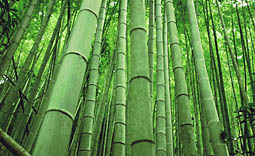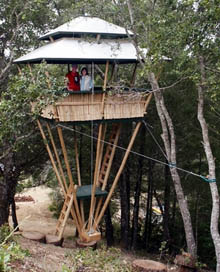
Plant steel - bamboo as an ecological building material
 |
Advocates call bamboo “the plant steel” with a clear reference to environmental protection. Bamboo is lighter than steel but five times stronger than concrete, and it grows on all continents except Europe and Antarctica. Unlike slowly growing trees that provide timber, bamboo shoots can grow several dozen centimeters a day. In the process, it absorbs up to four times more carbon dioxide, which causes global warming.
"The relationship between weight and strength is the best in the world. Anything built with steel I can build with bamboo faster and cheaper," says Colombian architect Simón Vélez. He almost exclusively trusts the material, which in the past was mainly associated with mats or musical instruments.
Vélez is also the author of the largest bamboo structure in the world. It is the temporary building of the Nomadic Museum in the capital of Mexico, covering over 5000 square meters. The museum was built according to the design of Canadian artist Gregory Colbert, who wanted to create an entire enormous building made entirely from renewable sources.
Vélez is completing another of his projects, a prototype energy-efficient store for the French chain Carrefour, in the hot city of Girardot, two hours' drive from his bamboo house in Bogotá. The building, with an area of 2000 square meters, has a vaulted roof made of bamboo, which unlike metal does not absorb heat. This reduces air conditioning costs.
 |
For this rebel, who works exclusively as a freelancer, bamboo is primarily an excellent material. Vélez's claims have been supported by seismic tests. Following a 7.7 magnitude earthquake that struck Costa Rica in 1991, all concrete and brick houses in the affected area collapsed. "However, there were also 20 bamboo buildings that stood firm, there wasn't a single crack on them," says bamboo physical properties expert Jules Janssen.
At a time when resources are diminishing and the world population is rising, the biggest advantage of bamboo as a building material is its ecological friendliness. Unlike steel, which is produced only in a few industrialized countries, there are over 1100 species of bamboo in tropical areas. The shoots grow almost everywhere, reducing the carbon dioxide level in the atmosphere and absorbing water as effectively as cacti in the desert.
Building with bamboo, however, is labor-intensive and could be expensive in some parts of the world. Vélez estimates that 80 percent of the costs of each of his projects go to pay the salaries of 300 specialized craftsmen who travel with him around the world. Most of them come from China's Guangdong province, where the architect built the first commercial bamboo building in the most populous country in the world.
However, the easy availability of bamboo is the main obstacle to its wider acceptance. It is most often seen as a building material for rickety makeshift shelters, which contributes to its stereotypical perception as wood for the poor.
According to San Francisco architect Darrel DeBoer, who specializes in renewable materials, bamboo may hold the greatest significance where it already grows. "In developing countries in the tropics, there is a need to create affordable housing. Building with bamboo can help with that and also create jobs," says DeBoer.
The English translation is powered by AI tool. Switch to Czech to view the original text source.
0 comments
add comment







